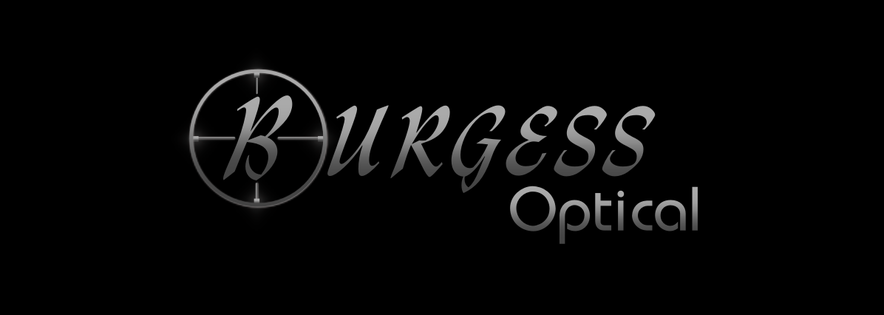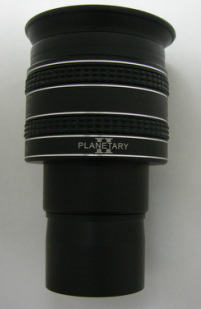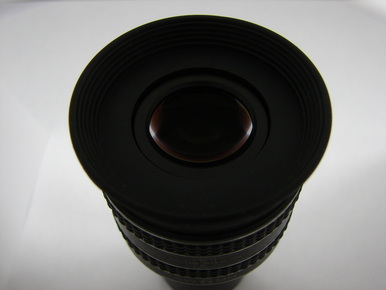Planetary Eyepieces
The Authentic Planetary II 6mm Now Sold Out!
|
*FOV - 60 degrees
*Eye Relief - 16mm |
1.25" 6MM II Planetary Eyepiece
|
*Height - Maximum: 9.5cm
Minimum: 7.5cm *Weight- 5oz |
The 6mm II is the only Planetary II Eyepiece produced by Burgess Optical Company.
What makes an eyepiece a planetary EP? The typical eyepiece today is designed for wide-field views of deep space objects (DSO). They offer a portal to the sky, where the DSO of interest is nicely framed. To achieve these nice, wide field of views, design choices have to be made, such as using a large number of elements and groupings of elements. These design choices sometimes result in lateral color. Lateral color is an aberration where different colors intercept the focal plane at different points and can be seen when viewing bright objects off-axis. When observing dim DSO, lateral color in the typical eyepiece is rarely seen. Also, these design choices sometimes result in light scatter, seen as a halo or glow around bright objects. Again, light scatter is rarely seen when observing dim DSO. If there is a bright star near the edge of the field, then lateral color and light scatter might be seen when observing dim DSOs. But, the lateral color and light scatter would be associated with the bright star, not the DSO.
The design choices for typical wide-field eyepieces are different than the design choices for a planetary eyepiece. The typical eyepiece is optimized for wide-field views of DSO and suffers when viewing very bright objects, particularly off-axis.
A planetary eyepiece is optimized to view bright objects while showing maximum detail and definition. It is an eyepiece with very high light transmission, very high contrast, minimal lateral color, and minimal light scatter. For Dobsonian users and others without tracking drives, lateral color and other aberrations are minimized to allow the planet to drift across the field of view while still being sharp and having high contrast. Also, because lunar and planetary observers seek to see as much detail as possible, planetary eyepieces typically have a short focal length for high magnification.
The design choices for typical wide-field eyepieces are different than the design choices for a planetary eyepiece. The typical eyepiece is optimized for wide-field views of DSO and suffers when viewing very bright objects, particularly off-axis.
A planetary eyepiece is optimized to view bright objects while showing maximum detail and definition. It is an eyepiece with very high light transmission, very high contrast, minimal lateral color, and minimal light scatter. For Dobsonian users and others without tracking drives, lateral color and other aberrations are minimized to allow the planet to drift across the field of view while still being sharp and having high contrast. Also, because lunar and planetary observers seek to see as much detail as possible, planetary eyepieces typically have a short focal length for high magnification.
The Planetary eyepieces have a twist-up eyecup for adjusting desired the eye relief from the top of the eyepiece. A light coating of lubricant has been applied to the threads in the twist-up eyecup. If any lubricant is visible on the inner eyepiece body with the twist-up eyecup in the extended position, remove the excess lubricant with a clean wipe, such as a tissue. Operate the twist-up eyecup several times, cleaning the body as necessary until no more lubricant is visible on the eyepiece body when the twist-up eyecup is fully extended.
The 4mm was bench tested by the designer, Thomas Back, who wrote in the BurgessRefractor Yahoo group on October 21, 2005:
"I first did a bench test with my Strehl .997 TMB 100mm f/8 SD apochromat, on the autocollimator. As you may know, I was very happy with the performance of the prototype of the 4mm. The production model is as good or better. The Airy disc was textbook, the off-axis aberrations were as low as any eyepiece I have tested in this field size and focal length, and the contrast and sharpness was superb."
Check out our construction and features:
"I first did a bench test with my Strehl .997 TMB 100mm f/8 SD apochromat, on the autocollimator. As you may know, I was very happy with the performance of the prototype of the 4mm. The production model is as good or better. The Airy disc was textbook, the off-axis aberrations were as low as any eyepiece I have tested in this field size and focal length, and the contrast and sharpness was superb."
Check out our construction and features:
- Designed by Thomas Back of TMB Optical
- Fully internally baffled
- Every Air to Glass surface has Multi Broadband coatings!
- Internal spacers have flat anodizing and micro-baffles to reduce reflections.
- Twist-up eyecups with flexible eyecups on top.
The designer, Thomas Back, has posted a message to the Yahoo BurgessRefractors group describing the path he has taken designing these eyepieces. Read that message here.
Copyright 2005 to 2022 Burgess Optical Company
All Rights Reserved. Designated trademarks and brands are the property of their respective owners.
All Rights Reserved. Designated trademarks and brands are the property of their respective owners.



